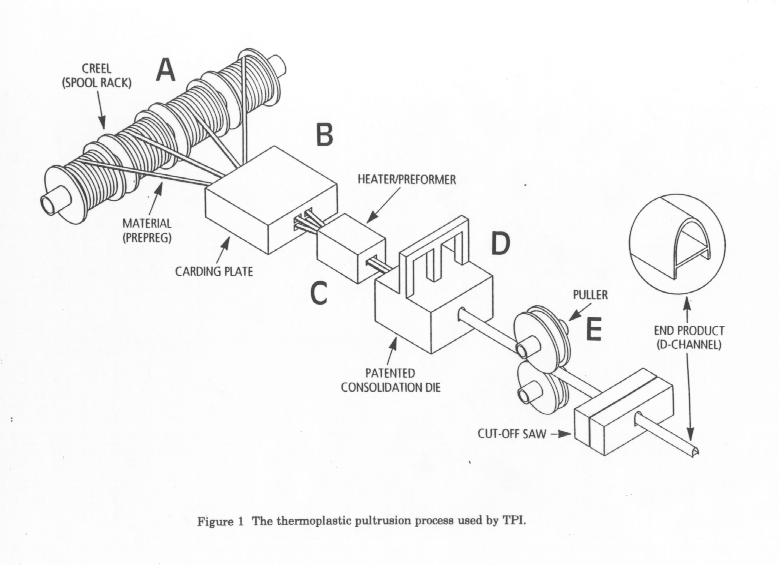Return to Memolist
MMA Memo 133: Visit to Thermoplastic Pultrusion, Inc.
Jingquan Cheng
National Radio Astronomy Observatory
Tucson, Arizona
July 13, 1995
On July 6, I visited Thermoplastic Pultrusion, Inc. ("TPI") of
Bartlesville, Oklahoma. TPI, a small firm located near Tulsa,
Oklahoma, is the SMA contractor for the CFRP tubes which are used for
the antenna backup structure. The company has been in business for
six years.
TPI's president, Dr. Scott Taylor, is a chemist who holds a
patent on pultruding thermoplastic structures using an ultrasonic
vibration device. The use of this ultrasonic technique allows
structure pultrusion to be performed below the melting point of the
resin. Vibrating the resin reduces the pulling force; therefore,
production speed is significantly higher. According to Dr. Taylor,
TPI is the only firm which manufactures products using this technique.
TPI has built its entire company around this process.
The firm possesses two pultrusion production lines. Fig. 1 is a
diagram of the CFRP tube production process. There are, essentially,
six steps in the TPI pultrusion process:
- In the diagram, A is the raw material, called "prepreg." Prepreg
is a type of CFRP strip which has only a single layer of fiber with
all the fibers in this layer aligned parallel to each other.
- The "carding plate" (see item B in Fig. 1) has a number of openings
which are specially arranged according to product shape. For example,
to produce a hollow section tube, a cantilever inserter is held and
supported before the carding plate. The inserter is extended to the
preformer (heater) and the consolidation die.
-
The preformer (see item C in Fig. 1) has a three-stage heating
element. The temperature of each stage is controlled by a
proportional controller. For a typical resin, such as polyphenylene
sulfide (PPS), the temperature of the first stage is 675øF and that
of the third stage is 625øF. The prepreg passes through the heater
where the layer of fibers are wet by the melting resin. After leaving
the heater, the prepreg is air-cooled.
-
By the time the material reaches the consolidation die (see item D in
Fig. 1), its temperature will be just below the melting point
(450ø F for PPS). The components of the consolidation die include
an ultrasonic generator, an ultrasonic wave guider, a pressure
generator and a shaping die. The ultrasonic generator used for
pultrusion is actually a modified ultrasonic welding generator. The
only differences are that the generator has a wider tuning range and
utilizes a smaller output power. The wave guider is a piece of metal
which is equivalent to half a wavelength; it is used to transfer the
power to the die area. The ultrasonic power increases the resin's
flow rate, even if its temperature is below the melting point. So,
the material can be pulled through the die to form the required shape.
The die is formed of a top part and a bottom part. The top part,
which is connected to a pressure generator, provides additional
pressure during the tube-forming process.
-
The fifth stage(see item E in Fig. 1) is the pulling device composed
of two linear motion mechanisms -- one produces a forward pulling
motion, the other a backward release motion.
-
The last stage of the process is the cutting saw.
The production line is capable of forming round tubes,
rectangular tubes, or other shaped sections. Round tubes present a
problem for this process -- since the inserter is hanging far away
from the die, it is prone to sag and this sagging means that wall
thickness in round tubes cannot be well-controlled. Typically, wall
thickness in a single round tube might vary by 1 mm or less. However,
for rectangular tubes, there is no problem, since material at the
bottom of the inserter prevents the inserter from sagging.
Additional TPI capabilities include:
-
In-house production of prepreg. The TPI prepreg is produced by using fibers and resin. It is
about one-third cheaper than that bought from outside (approximately $20.00/lb for TPI
prepreg vs. $30.00/lb for outside material).
-
Tensile modulus testing. TPI has a tensile modulus testing device. During the production of
the SMA tubes, all tubes were tested and passed. (Note: thermal testing is contracted outside.)
-
Production of stainless steel tube ends. These tube ends are fitted using a uniform layer of
epoxy. The epoxy thickness is controlled by two nylon strings which are wraped around the end
to form four equal spaced lines between the end and the tube. Pulling tests show that the epoxy
is stronger than the tube resin.
During the visit, Dr. Scott talked about the differences between
thermoset and thermoplastic composites. Thermosets, which are
typically epoxy, have high compressive strength, low elongation and
low impact resistance. In contrast, the thermoplastics have low
compressive strength, high elongation and high impact resistance.
Also, thermoplastics can be re-heated and re-joined. Dr. Scott showed
me several joining techniques for the CFRP structure.

mma@nrao.edu

